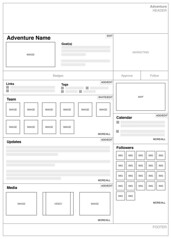The uncanny valley is a term from the world of robotics, which states that when something appears almost perfect, it can cause a negative reaction*. Or, to be more precise:
The uncanny valley hypothesis holds that when robots and other facsimiles of humans look and act almost like actual humans, it causes a response of revulsion among human observers.
Source: Wikipedia
I’m talking about the uncanny valley in regards to creating prototypes, so revulsion may be too strong a term; but I think the principle still applies.
I was lucky enough to attend UX London recently, and one of the workshops in which I participated was Mark Baskinger and William Bardel’s Quick Sketching for Interaction Design. In this workshop we were taught to draw squares, and one of the key tips we were given was to make them good, but not perfect; if the corners don’t have a little overlap, your prototype sketches start to look complete and are less inviting for comment and participation.

There’s another way in which small imperfections can work in your favour. While my sketches (such as this one, for a project which, unfortunately, never saw the light of day) could never be accused of being too perfect – that’s the reason I attended the workshop, after all! – I do like to use the same principle in my more formal wireframes:
Although I use a basic grid to provide regularity to the eye (usually 3/6 columns), I make sure that large blocks of ‘text’ don’t end at the same point:

This is only a small detail, but it more accurately mimics how text appears on pages, and suggests to the viewer a more realistic impression of how the final page will appear, where a series of identical, regular blocks would appear false. That small detail can help get your prototypes approved.
* Scott McCloud looks at the subject from a different angle in his excellent book, Understanding Comics:


[…] On the Uncanny Valley & Creating Prototypes […]
Contour Bias And The Uncanny Valley: Anthropomorphic Forms Part II | Van SEO Design [December 16th, 2010, 13:36]